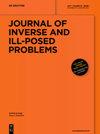无界域上求解Helmholtz方程Cauchy问题的Robin-Dirichlet交替迭代法
IF 0.9
4区 数学
Q2 MATHEMATICS
引用次数: 1
摘要
摘要研究了一类具有定义域的Helmholtz方程的Cauchy问题 {\mathbb{R}^{d}} , d≥2 {d\geq 2} 有N个圆柱出口到无穷远,有界包含在h - 1中。 {\mathbb{R}^{d-1}.} 在有界域的边界上规定柯西数据,目的是在边界的无界部分上求解。1989年,Kozlov和Maz 'ya[14]提出了一种求解有界域中椭圆算子、自伴随算子和正定算子的柯西问题的交替迭代方法。对于求解与亥姆霍兹型算符相关的柯西问题,存在着该方法的不同变体。我们考虑了Berntsson, Kozlov, Mpinganzima和Turesson(2018)[4]在有界域中提出的变体,并推导了该过程在无界域中收敛的必要条件。在数值实现上,采用有限差分法在一个简单的矩形域上求解问题 {\mathbb{R}^{2}} 表示截断的无限条。数值计算结果表明,通过适当截断域和选择适当的Robin参数,μ 0 {\mu_{0}} 和μ 1 {\mu_{1}} , Robin-Dirichlet交替迭代法是收敛的。本文章由计算机程序翻译,如有差异,请以英文原文为准。
Robin–Dirichlet alternating iterative procedure for solving the Cauchy problem for Helmholtz equation in an unbounded domain
Abstract We consider the Cauchy problem for the Helmholtz equation with a domain in ℝ d {\mathbb{R}^{d}} , d ≥ 2 {d\geq 2} with N cylindrical outlets to infinity with bounded inclusions in ℝ d - 1 . {\mathbb{R}^{d-1}.} Cauchy data are prescribed on the boundary of the bounded domains and the aim is to find solution on the unbounded part of the boundary. In 1989, Kozlov and Maz’ya [14] proposed an alternating iterative method for solving Cauchy problems associated with elliptic, self-adjoint and positive-definite operators in bounded domains. Different variants of this method for solving Cauchy problems associated with Helmholtz-type operators exists. We consider the variant proposed by Berntsson, Kozlov, Mpinganzima and Turesson (2018) [4] for bounded domains and derive the necessary conditions for the convergence of the procedure in unbounded domains. For the numerical implementation, a finite difference method is used to solve the problem in a simple rectangular domain in ℝ 2 {\mathbb{R}^{2}} that represent a truncated infinite strip. The numerical results shows that by appropriate truncation of the domain and with appropriate choice of the Robin parameters μ 0 {\mu_{0}} and μ 1 {\mu_{1}} , the Robin–Dirichlet alternating iterative procedure is convergent.
求助全文
通过发布文献求助,成功后即可免费获取论文全文。
去求助
来源期刊

Journal of Inverse and Ill-Posed Problems
MATHEMATICS, APPLIED-MATHEMATICS
CiteScore
2.60
自引率
9.10%
发文量
48
审稿时长
>12 weeks
期刊介绍:
This journal aims to present original articles on the theory, numerics and applications of inverse and ill-posed problems. These inverse and ill-posed problems arise in mathematical physics and mathematical analysis, geophysics, acoustics, electrodynamics, tomography, medicine, ecology, financial mathematics etc. Articles on the construction and justification of new numerical algorithms of inverse problem solutions are also published.
Issues of the Journal of Inverse and Ill-Posed Problems contain high quality papers which have an innovative approach and topical interest.
The following topics are covered:
Inverse problems
existence and uniqueness theorems
stability estimates
optimization and identification problems
numerical methods
Ill-posed problems
regularization theory
operator equations
integral geometry
Applications
inverse problems in geophysics, electrodynamics and acoustics
inverse problems in ecology
inverse and ill-posed problems in medicine
mathematical problems of tomography
 求助内容:
求助内容: 应助结果提醒方式:
应助结果提醒方式:


